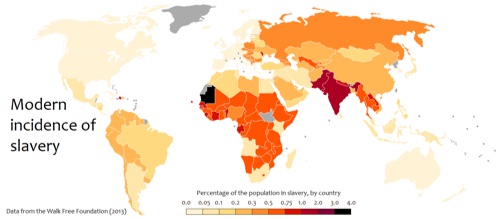Slavery… Today

Every Passover, Jews read passages from the Haggadah that tell us to visualize ourselves as former slaves who were just freed from the bondage. To some, the request seems antiquated. In the modern mind, slavery has become obsolete, a relic of some bygone era. Right?
Think again! Studies suggest that there are more slaves today than at any previous point in history… as much as 27 million!
The modern form of slavery can be found in every country, even the United States. The US State Department estimates that 17,500 slaves are smuggled in the US annually! They may be forced to do difficult farm labor or to attend to their master in his home, just like the slaves of old.
Of course, slave trading is officially barred by international law. Since 1817 more than 10 international treaties have been signed to outlaw transactions involving slaves. Illegal as it may be, though, slavery continues to be practiced – often with the tacit consent of corrupt authorities.
In India slavery is camouflaged under the mantle of “paying off a debt.” A wealthier farmer may lend a minimal sum to an indigent neighbor, whose son or daughter will be handed over to work off the debt. Their term of indemnity will be “as long as it takes to pay off the debt” – usually, that means forever.
Not only will the child remain enslaved for life, but should they marry and have children, those children are born into the bondage as well. In this manner a family can be enslaved indefinitely for generations to pay off a minor loan taken out by the great-grandfather. In practice, entire villages can be trapped in endless servitude.
There are countries around the world where people are drafted into slavery by powerful organizations, or even by the government itself. Several African countries use the services of forced child soldiers. In South America slaves are forced to harvest crops which are the sold to industrial countries. A large percentage of these laborers are children who were kidnapped and then sold as though they were objects.
In Pakistan young ones are forced to weave carpets. In Ivory Coast kids are beaten and starved on the cacao plantations. In Egypt or other Arab lands maintaining slaves remains a common practice.
Within hours of the terrible earthquake that struck Haiti in January 2010, criminal groups swarmed into the devastated country. Slavery had been a problem before the earthquake but suddenly skyrocketed. Similarly, the tsunami that struck in the Indian Ocean in 2004 not only left 300,000 dead and millions more without a roof, it also left some of those millions at the mercy of kidnappers.
The bottom line is that slavery continues today on a grand scale.
Until about 20 years ago, world leaders denied the problem existed, certainly not on the grand scale it is recognized today. (The International Labour Organization estimates that in 2005 the international trade in humans reached a monstrous $32 billion!)
A significant step in the right direction took place in 2000 when President Bill Clinton signed into law the Victims of Violence and Trafficking Protection Act. In 2012, President Obama signed an executive order to help the US government enforce its zero-tolerance policy against human trafficking.
Be that as it may, slavery is very much alive and well in the modern world. We should not take our freedom for granted. This Passover, pause for a moment and acknowledge how literally true it is that “If God had not taken our fathers out of Egypt, we and our children and grandchildren would still be enslaved.”
Subscribe to our blog via email or RSS to get more posts like this one.
Posted in:
Hot Topics;
Jewish Beliefs & Philosophy
by
Yaakov Astor
![]() March 19, 2015
March 19, 2015


